Pearl Zhu's Blog, page 1289
October 9, 2016
The New Book “Change Insight” Introduction Chapter 1: The Psychology behind Changes
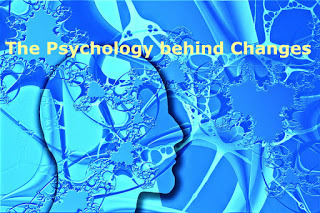 Change is only constant, the speed of change is accelerated. Organizations have to manage change effectively in order to implement their strategy cohesively. However, more than two-thirds of Change Management fail to reach the expectation. What’re the psychology behind the change, why do people resist changes? What would be a good way to empower change capabilities? And how to manage change not as a one-time project, but an ongoing capability?
Change is only constant, the speed of change is accelerated. Organizations have to manage change effectively in order to implement their strategy cohesively. However, more than two-thirds of Change Management fail to reach the expectation. What’re the psychology behind the change, why do people resist changes? What would be a good way to empower change capabilities? And how to manage change not as a one-time project, but an ongoing capability?
People like to change, but do not want to be changed: It would be great for change practitioners to have a reasonably good understanding of neuroscience; since it does help understand people’s responses to changes. People respond in different ways to different situations, hence, change practitioners need to have good critical thinking skills, high level of adaptability, communication and engagement skills. The more transparent about a change effort, the less uncertainty there will be about the effort. People resist changing mostly because they have experienced disasters around previous efforts that they do not trust their leaders, poor change experiences, lack of compelling rationale, a poorly designed implementation plan, unworkable designs created incorporate changes that have stopped in the middle, all have created extra work and disruption for little or no gain. People ate thus resist being forced into senseless or avoidable sacrifices, having to restructure based on a shallow or ill-defined problems or transform without their assent, being treated as objects.
There is a distinct relationship between a person’s emotional state and small or expansive thinking: When people experience a state of anxiety or uncertainty, they tend to drift back to the comfort of small thinking and getting their minds around points of detail. When that anxiety is removed and they experience more certainty, they have the courage to thinking more expansively. So the challenge with change is to create emotional states that mean certainty for the individuals affected, and have it stick. Not easy, but not impossible. It is all about perspective. What is more interesting is what drives people’s perspectives, many people have no energy or desire left to think longer term. In addition, people all have biases, awareness of them is important, many of such biases are apparent at the same time, sometimes complementing each other and other times contradicts each other, so that you can reduce the harmful impact they might have, and leverage upon the beneficial. Make sure that when you make decisions on changes, they are not based on opinions, but on a commonly understood starting points to make changes.
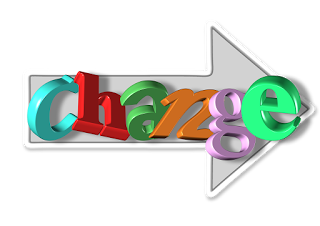 There are five personalities to deal with in Change Management: Change is inevitable, and the only differences are the reasons and goals behind the change and its scope, depth, and breadth - why to change, what you need to accomplish, what does it consist of and what does it impact. There are five personalities from Change Management perspectives: Pathfinder, Listener, Organizer, Follower, Resistor. People look for “What’s In It For Me.” Given this, Change Management needs to craft and most importantly deliver these messages at both the individual and group level, and most importantly reinforce these statements through consistent action. Resistance to change isn’t necessarily the problem since it’s a natural human response to the loss or fear of uncertainty, it could be a balancing mechanism and one of the change’s biggest opportunities. If you can tap into, better understand and work with the energy of resistance you can also accelerate purposeful changes.
There are five personalities to deal with in Change Management: Change is inevitable, and the only differences are the reasons and goals behind the change and its scope, depth, and breadth - why to change, what you need to accomplish, what does it consist of and what does it impact. There are five personalities from Change Management perspectives: Pathfinder, Listener, Organizer, Follower, Resistor. People look for “What’s In It For Me.” Given this, Change Management needs to craft and most importantly deliver these messages at both the individual and group level, and most importantly reinforce these statements through consistent action. Resistance to change isn’t necessarily the problem since it’s a natural human response to the loss or fear of uncertainty, it could be a balancing mechanism and one of the change’s biggest opportunities. If you can tap into, better understand and work with the energy of resistance you can also accelerate purposeful changes. Change should be viewed as an opportunity, it’s the opportunity to either solve a business problem or improve productivity or cut costs or improve a product or service. TO achieve desired change, an organization must create an environment that enables effective collaboration, shares and promotes ideas, and provides necessary incentives for employees, empower your change agents, and reward your change champions. Therefore, neither change nor resistance to change is a problem. Instead, leadership, communication, and engagement are the keys to successful change or lack thereof is the problem. Change Management is not a standalone subject matter. It is part of the strategy, which if done properly, includes the change in the process. Follow us at: @Pearl_Zhu
Published on October 09, 2016 22:59
Three Payoffs of IT Digital Transformation
 IT is impacting every business functions, permeating everywhere in the business, and is becoming the driver of business change. However, most of the IT organizations still get stuck at the lower level of maturity, react to the business changes. And most of IT organizations still measure IT via system performance from IT operational lenses, evaluate IT project on budget and on time, or IT department cost commitment. How can IT reinvent itself as a value created business partner, and what are payoffs of IT digital transformation and how to measure IT performance via the true value IT delivers to the business and the lenses of customer satisfaction? Organizational responsiveness: Digital IT should be run as a changing organization, to break down silos and keep the business flow via the mosaic digital technologies. People normally 'close' the boundaries of the system, so that less energy is transferred and, therefore, the fewer changes happen in the system, due to the fear of stepping out of the “comfort zone.” For the area of responsiveness and technology, the most important questions CIOs can ask their business partners are: Are there any tools your competitors apply that you need to look at? Are your tools simple to use? These questions help show a willingness to engage people outside of IT on how best to solve a problem, or achieve an opportunity. Engage all employees in improving their processes, and create the expectation that positive behaviors and mutual respect are valued above everything else. The payoff of IT digital transformation is about how IT will enable business agility, how fast IT will deliver the required business capabilities effectively and efficiently. The more alignment between business and IT the more level of agility for both will be achieved. The challenge and direction now are to bring agility holistically to the entire business.
IT is impacting every business functions, permeating everywhere in the business, and is becoming the driver of business change. However, most of the IT organizations still get stuck at the lower level of maturity, react to the business changes. And most of IT organizations still measure IT via system performance from IT operational lenses, evaluate IT project on budget and on time, or IT department cost commitment. How can IT reinvent itself as a value created business partner, and what are payoffs of IT digital transformation and how to measure IT performance via the true value IT delivers to the business and the lenses of customer satisfaction? Organizational responsiveness: Digital IT should be run as a changing organization, to break down silos and keep the business flow via the mosaic digital technologies. People normally 'close' the boundaries of the system, so that less energy is transferred and, therefore, the fewer changes happen in the system, due to the fear of stepping out of the “comfort zone.” For the area of responsiveness and technology, the most important questions CIOs can ask their business partners are: Are there any tools your competitors apply that you need to look at? Are your tools simple to use? These questions help show a willingness to engage people outside of IT on how best to solve a problem, or achieve an opportunity. Engage all employees in improving their processes, and create the expectation that positive behaviors and mutual respect are valued above everything else. The payoff of IT digital transformation is about how IT will enable business agility, how fast IT will deliver the required business capabilities effectively and efficiently. The more alignment between business and IT the more level of agility for both will be achieved. The challenge and direction now are to bring agility holistically to the entire business.
Information fluency: Digital is the age of insight. Information is structured and presents facts in context to targeted situations and conditions that facilitate business in making the right decisions at the right time. Given this assertion, there is no limit to the value of information in the digital economy. At the age of IT consumerization and customer-centricity, businesses need to understand not only the power and the opportunity information could bring in, but also the potential risks they might get exposed to. IT plays an important role in interpreting business issues into a technology solution, also, leverage necessary resources to solve them. The payoff of IT digital transformation is to keep information flow, capture the business foresight and customer insight timely for grasping the emergent opportunities to grow businesses and delight customers. Digital ecosystem is complex and volatile, for complex problem solving, understanding context is often the first and the important step in understanding, create the relevant context to make a more lasting solution - without it, you are working without any boundaries, or basis for understanding what you are doing.
 Capability differentiator: Traditional IT was run as a commodity servicer provider which spends most of the resources on “keeping the lights on.” Digital IT organizations need to focus on value and capability building. It will mean that the enterprise view, customer perspective, business competency, risk intelligence, and vendor management are the most important elements of an IT organization. IT should spend more resources upon crafting unique business capabilities and capturing business growth opportunities. Both information and technology become the key ingredient in building business capabilities that differentiate the company from its competition in supporting the company objectives. In this regard, the payoff of digital IT organization should gain more strength as an innovation engine. Let revenue generation or increase become the focus vs. cost savings/ optimization. That's not to ignore the cost completely.
Capability differentiator: Traditional IT was run as a commodity servicer provider which spends most of the resources on “keeping the lights on.” Digital IT organizations need to focus on value and capability building. It will mean that the enterprise view, customer perspective, business competency, risk intelligence, and vendor management are the most important elements of an IT organization. IT should spend more resources upon crafting unique business capabilities and capturing business growth opportunities. Both information and technology become the key ingredient in building business capabilities that differentiate the company from its competition in supporting the company objectives. In this regard, the payoff of digital IT organization should gain more strength as an innovation engine. Let revenue generation or increase become the focus vs. cost savings/ optimization. That's not to ignore the cost completely.
Information technology should be seen by any business as a “digital transformer and focus on VALUE proposition to run a digital IT. The payoff of IT digital transformation is not just for the quick win, but to build the long term business competency. IT is the key element of the business capabilities. IT innovation capabilities directly impact how it helps the business gain competitive advantage and capture upcoming trend to compete for the future.
Follow us at: @Pearl_Zhu
Published on October 09, 2016 22:56
October 8, 2016
The New Book “Change Insight” Introduction
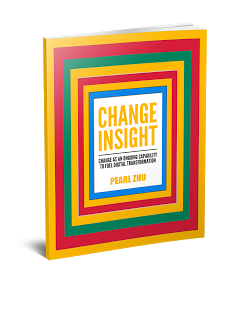 There are many books written about changes, but very few dig into the mindset level. Change Management starts with a thought, with a flash of insight, insight is the act or result of understanding the inner nature of changes or of seeing things intuitively. It leads to a vision; then leads to a culture shift, strategic changes, or leadership transformation. Change Management is always challenging with a high percentage of failure rate. Indeed, change is difficult. Some say, change is not a problem, the primary reason for change failure is resistance to change while the secondary reason is the inability of leaders to deal with resistance. The purpose of the book “Change Insight” is to understand change holistically and manage change systematically.
There are many books written about changes, but very few dig into the mindset level. Change Management starts with a thought, with a flash of insight, insight is the act or result of understanding the inner nature of changes or of seeing things intuitively. It leads to a vision; then leads to a culture shift, strategic changes, or leadership transformation. Change Management is always challenging with a high percentage of failure rate. Indeed, change is difficult. Some say, change is not a problem, the primary reason for change failure is resistance to change while the secondary reason is the inability of leaders to deal with resistance. The purpose of the book “Change Insight” is to understand change holistically and manage change systematically.
Chapter 1 The Psychology behind Changes: It would do good for Change practitioners to have a reasonably good understanding of neuroscience; since it does help understand people's responses to change. People respond in different ways to different situations, and some people perceive less risk when compared with others. The fear of consequences; the perception / response to consequences vary from person to person, and that's what makes change interesting and challenging. Hence, change practitioners need to have good critical thinking skills, high level of adaptability, communication and engagement skills.
Chapter 2 People-Centric Change Management: Digital is the age of people. The human element of change entails a people-centric approach to management style; thus, empowering the workforce to embrace change is a most effective, efficient and result-oriented management in organizations. People are the center of any Change Management, and people are also the weakest link in any change effort as well, do not expect everyone supporting your change initiatives to the same degree, it’s even no surprise that only small percentage of people are changing agents.
Chapter 3 Change Leadership: Fundamentally leadership is about change and influencing people to change. Leadership is the capacity to influence others through inspiration, motivated by a passion, generated by a vision, birthed by a conviction of a sense of purpose of why you were created. Leadership is moving you and others, and it is about change and evolving to what is needed next. Three things that are inexorably linked together are change, growth, and learning. It may be human nature to resist change but not for great leaders. Effective leaders have a very high comfort level with change and understand standing still is not an option in today's world. Doing things differently is just part of everyday life for a leader who is always in the midst of change--envisioning it, planning it, or leading it.
Chapter 4 Change Principles: Change is not for its own sake, it is an ongoing business capability to execute the strategy and compete for the future. Change Management principles are general rules and guidelines, intended to be enduring, that inform and support the way in which an organization sets about managing change effectively. The style of the principle should be short and recognizable. Its definition describes "what" the principle means in the language understood by stakeholders. The motivation describes "why" the principle is important to achieving the change strategy and goals. The implications describe "how" the principle changes behavior.
Chapter 5 Change as an Ongoing Capability: Change is a volatile subject, just like change itself. Everything changes continuously by following the laws of evolution, and the rate of change is accelerated. Corporate change can be a simple modification of strategy, a business process improvement, a technology update, or a more radical digital transformation. Either at the individual or an organizational level, change is a one-time project at the static industrial age; but change has to become an ongoing capability at the digital era.
Chapter 6 The Pitfalls of Change Management: Change is inevitable, and the speed of change is increasing. How capable the business is handling change would directly impact on the business competency. Organizations today are more dynamic than ever, there are Big ’C’ changes such as digital transformation, merging organizations with overlapping or duplicate functions, and little ‘c’ changes such as implementing a new software tool, reorganizing a department, improving a new process to do things more efficiently. However, there is a high failure rate of Change Management statistically, and more than two-thirds of business Change Management effort fail to achieve the expectation. So what are the big barriers and potential pitfalls on the way, how to improve change success rate, and craft change as an ongoing digital capability?
Chapter 7 Change Assessment and Measurement: Change is inevitable, and the speed of change is accelerating! For digital organizations today, Change Management is an ongoing capability, not just a one-time initiative. Measuring is a good starting point to change. A change manager needs to assess business “changeability” and evaluate every specific scenario to create the change program success. Ultimately the success of the change program is measured by results that are important values to the organization. And the cultural adoption of these goals is part of that measure. If these values have not been clearly identified at the outset - you cannot get the true alignment of your organization and all working toward the same goals and outcomes, you lack clarity and purpose of direction for changes.
 Chapter 8 Building High-Mature Organizations with Changeability: Digital makes a profound impact from a specific function to the business as a whole, the purpose of such radical digitalization is to make a significant difference in the overall levels of customer delight and achieve high performing business result, to ultimately build a high mature digital organization. In reality, an organization or company may be in business for many years but has not matured its management practices or lack of well-defined sets of business principles to manage the business with a systematic approach. Most of the organizations stick to the lower level of maturity mode (reactive, inside-out, and operational driven), how can they move up the maturity level to become truly proactive and outside-in, culture intelligent and people-centric?
Chapter 8 Building High-Mature Organizations with Changeability: Digital makes a profound impact from a specific function to the business as a whole, the purpose of such radical digitalization is to make a significant difference in the overall levels of customer delight and achieve high performing business result, to ultimately build a high mature digital organization. In reality, an organization or company may be in business for many years but has not matured its management practices or lack of well-defined sets of business principles to manage the business with a systematic approach. Most of the organizations stick to the lower level of maturity mode (reactive, inside-out, and operational driven), how can they move up the maturity level to become truly proactive and outside-in, culture intelligent and people-centric?
Digital means change with increasing velocity and speed. "Change management" is the overarching umbrella, that encompasses extensive planning, outreach, communications, discovery of concerns, objections, and potential points of failure, addressing fears and resistance, developing a shared vision, communicating valid and compelling reasons for cooperation, recognizing sacrifice and incremental success, measuring outcomes in a shared and mutually understood and agreed upon fashion, being able to declare an end-point and successful conclusion.
“Change Insight” Book Ordering Link on IBook“Change Insight” Book Slideshare PresentationFollow us at: @Pearl_Zhu
Published on October 08, 2016 23:02
The Book “Thinkingare” Quote Collection III
 The term digital " THINKINGAIRES" we advocate in this book refers to the talented digital leaders and professionals who continue to create new ideas, to practice thought leadership, and to bring the world both content richness and context intelligence. Here is a set of quote collections from "Thinkingaire," to convey the quintessential of multidimensional digital thinking.
The term digital " THINKINGAIRES" we advocate in this book refers to the talented digital leaders and professionals who continue to create new ideas, to practice thought leadership, and to bring the world both content richness and context intelligence. Here is a set of quote collections from "Thinkingaire," to convey the quintessential of multidimensional digital thinking.
51 Paradoxes are conflicting choices or conditions that demand equal attention.52 Almost all of humankind’s problem are rooted in mindset, and the majority of them are caused by extreme thinking or polarized thinking.53 Understand ego as a state of awareness.54 An excellence mind pursues perfecting, not perfection.55 As with any things, regret itself is not the problem, it’s what you do with it.56 Like many things, power is like the two sides of a coin.57 The paradox is the result of two opposing truths existing side by side, which can be both right.58 Carpenters have a pretty good working balance: “Measure twice, Cut once.”59 The mindset (perspective) is the consequence of “rules.”60 A misfit is like the round peg that cannot fit into the square hole or the running river that just can’t stay still. 61 Value is multidimensional and situational.62 A benchmarking mind is an “interpreter” mind which can bridge the gaps.63 A high-performing digital mind can think logically, but outside of the box as well.64 Not every win is worth the winning, winning without purpose or value is the loss of character or integrity.65 True success means one is able to see the seed of failure in every success and with every success the possibility of failure.66 Open the mind to be on a path to a better version of yourself.67 Thought leadership is by nature evolutionary, in that it must always be part of an ever-evolving flow.68 Inspiration is the result of moments of insight and a key component of internal “drive.”69 Focus provides motivation and demolishes negative emotions.70 The brain is to mind as the eye is to sight.71 A mind is not profound by itself, just like a tree without a root.72 It is perhaps one of the most widely recognized symbols in the world to analogize innovation as a light bulb.73 A great digital leadership mind is like a valley, open, but not empty, profound, but not depressive.74 A child-like mind is full of imagination.75 Self-awareness mind helps you build on your strengths and improve on your weaknesses.76 Resilience is an elastic property or component of a person77 Pattern Thinking is a type of problem-solving thinking.78 A positive mind reflects many of the Sun’s characteristics: brightness, nourishment, and vibrance.79 It takes a decade to grow a tree, and it takes more than one generation to shape the right mindset.80 Psychology is a condensed version of mindset; whereas philosophy is an abstract of the human society.81 Holistic wisdom is the hallmark of the holistic mindset.82 Not every leader is a philosopher, but each leader should cultivate a philosophical mindset.83 Imagination, abstraction, creativity, and coherence etc are some inherently cognitive and mental elements of architect-wise thinking.84 Ecosystem thinking is systematic thinking about ecosystem and environment.85 An artist’s mind is imaginative and dynamic.86 Seeing things via VC’s lenses can help you manage opportunities and risks with priority, agility, and resilience.87 Anti-digital mindsets are those “status quo” types of thinking, authoritarian attitude, and bureaucratic decision-making.88 Silos will continue to be inevitable as long as the rewards for collaboration are outweighed by the rewards for competition.89 Stereotyping as a term has a negative connotation.90 Focus on the part and the whole at the same time.91 Learning to think beyond a single dimension, look beyond the surface, love more than one color and enjoy the world of differences.92 The paradox o indecisiveness lies in uncertainty.93 Change Agents have a “learning wheel” in their mind.94 The problem of “Command-Control is that you can control people’s behavior, but not their mind.95 No two people are absolutely identical: we are each unique.96 Complacency almost always stems from a sense of success or living in a comfort zone.97 Using two-dimensional lenses to perceive the multi-faceted world can limit your ability to observe the world more objectively.98 Wisdom is the intelligent use of our knowledge, whereas sensibility is an intelligent use of our judgment.99 You have to be able to look objectively at the problem, deflating the emotional part of it.100 Speaking the unspeakable. As a leader, you need to not just listen to what’s being said, but more importantly, what's not being said.101 Digital professionals with growth mind can step out of their own comfort zone more easily, walking the talk and leading change more confidently.102 Strategic Thinking = Systems Thinking + Creativity + Vision
 103 Critical Thinking narrows and creative thinking expands, but they must work in tandem for problem solving and decision making.104 Analysis and synthesis are different mental muscles to serve different purposes.105 Mechanistic thinking focuses on “what,” and holistic thinking digs into “why.”106 To be creative you must set aside both certainty and doubt.107 Visionary minds are in demand to bear us into the dawn of the deep digital era.108 Hire digital mindsets, train for skills.109 Character is an important differentiator between extraordinary and ordinary, between a real leader and a follower.110 The mind is an innovation engine of any human progress, but also the root cause of almost all human problems.111 The discipline of FOCUS that is necessary to think profoundly is certainly difficult for many people to achieve.112 Be a Thinkingaire!
103 Critical Thinking narrows and creative thinking expands, but they must work in tandem for problem solving and decision making.104 Analysis and synthesis are different mental muscles to serve different purposes.105 Mechanistic thinking focuses on “what,” and holistic thinking digs into “why.”106 To be creative you must set aside both certainty and doubt.107 Visionary minds are in demand to bear us into the dawn of the deep digital era.108 Hire digital mindsets, train for skills.109 Character is an important differentiator between extraordinary and ordinary, between a real leader and a follower.110 The mind is an innovation engine of any human progress, but also the root cause of almost all human problems.111 The discipline of FOCUS that is necessary to think profoundly is certainly difficult for many people to achieve.112 Be a Thinkingaire!Follow us at: @Pearl_Zhu
Published on October 08, 2016 22:58
Three Disconnect to Stop IT from Unleashing its Full Potential
 We live in a fast-paced digital world, and every day, the exponential growth of information plus emergent technologies affect the way we live, think, and love. Digital transformation is inevitable, opportunities and risks co-exist - roadblocks, pitfalls, and disruption are around every corner. IT leaders have to overcome many barriers and deal with quite a few of IT management dilemmas in transforming IT from a cost center to value creator, from a support function to a strategic business partner; from a back office to an innovation front yard. Here are three disconnects to stop IT from unleashing its full potential?
We live in a fast-paced digital world, and every day, the exponential growth of information plus emergent technologies affect the way we live, think, and love. Digital transformation is inevitable, opportunities and risks co-exist - roadblocks, pitfalls, and disruption are around every corner. IT leaders have to overcome many barriers and deal with quite a few of IT management dilemmas in transforming IT from a cost center to value creator, from a support function to a strategic business partner; from a back office to an innovation front yard. Here are three disconnects to stop IT from unleashing its full potential?
Silo thinking and effects are one of the biggest obstacles for IT and the business as a whole to achieve high performance and high maturity: Silos are a product of organizational insecurity and internal competition for resources. This is a cultural problem resulting from poor leadership and bureaucratic management style. In business circumstances, say, you have groups of people who will execute whatever comes down the pipeline, and those that have problems with tasks will ask questions. How these questions are handled, more than anything else, will tell you the health of the organization, do they have a silo mentality or have a holistic perspective. Silos have individual goals, but strategic goals need to be shared and common to ensure the whole is optimal than the sum of pieces. Top leaders who are someone above the silo are supposed to connect all the individual puzzle pieces together. Great organizations are supposed to maximize the individual and the group. Open communication and sharing increase the ability to fulfill your mission, satisfy your customer or client base, and improve employee productivity and engagement.
The gaps between the business strategy and IT strategic goals, as well as disconnect between IT goals and employees' performance mapping are the barriers to stop IT from unleashing its full potential: In most organizations, the business strategy is an archived document by which daily decisions are rarely driven. Hence, strategy management and change management should go hand-in-hand, strategy and execution are not linear steps, but an iterative continuum. Unfortunately, these days the change is forced, and people are not often involved, the transformational change is becoming “technology” change, and people side of change is completely ignored. The group does not have a clear, mutually agreed-upon approach: mechanics, norms, expectations, rules, etc.Often the middle management are the bottleneck and do not want to change. The digital transformation effort fails when change is forced, you can implement system and process, but the organization will suffer. Nobody will be happy and productivity will decline, employees’ engagement is low, innovation is stifled. Effective and proactive change and improvement can originate routinely from staff level as well as through specific change mandates from senior management. The key issue is whether management recognizes a need for improvement and will support both the changes and the necessary change management and training/orientation.
 The wrong cause of the problem will perhaps grow new or larger problems and create the disconnect between IT and the business: Either for individuals, organizations, or society as a whole, the problem-solving capability is crucial to surviving and thriving. Often times, people have a tendency to try to fix a symptom which results from the actual cause of the problem. When they do this, they allow problems to grow under the surface, out of sight, out of mind, until it’s too late. So trying to fix the wrong cause of a problem will waste time and resources, increase anxiety and lead ineffectiveness. From a management perspective, many decision-makers fail to fully grasp and accurately perceive what leads to problems and difficulties.better solution that crosses all industries is to keep peeling back the layers to find the root cause through asking big WHYs, or taking systematic approaches - to discover the real cause, and address it. From talent management perspective, when people are not working via the system to solve the real problems but play with the system, fix the symptom or build “comfort zones” which causes frictions to changes and stifles innovation, you know that there is the serious problem, and there are many possible causes of it. From process management perspective, the elements of an outdated system are built using out-of-favor or at least depreciated tools, running on out-of-favor platforms, or documentation not matching the actual system. The bad systems are also possibly caused by complicated processes or inflexible procedures with unnecessary complexity. The good alignment of people, process, and technology is important in connect the right dots and solve the real problems in a structural way.
The wrong cause of the problem will perhaps grow new or larger problems and create the disconnect between IT and the business: Either for individuals, organizations, or society as a whole, the problem-solving capability is crucial to surviving and thriving. Often times, people have a tendency to try to fix a symptom which results from the actual cause of the problem. When they do this, they allow problems to grow under the surface, out of sight, out of mind, until it’s too late. So trying to fix the wrong cause of a problem will waste time and resources, increase anxiety and lead ineffectiveness. From a management perspective, many decision-makers fail to fully grasp and accurately perceive what leads to problems and difficulties.better solution that crosses all industries is to keep peeling back the layers to find the root cause through asking big WHYs, or taking systematic approaches - to discover the real cause, and address it. From talent management perspective, when people are not working via the system to solve the real problems but play with the system, fix the symptom or build “comfort zones” which causes frictions to changes and stifles innovation, you know that there is the serious problem, and there are many possible causes of it. From process management perspective, the elements of an outdated system are built using out-of-favor or at least depreciated tools, running on out-of-favor platforms, or documentation not matching the actual system. The bad systems are also possibly caused by complicated processes or inflexible procedures with unnecessary complexity. The good alignment of people, process, and technology is important in connect the right dots and solve the real problems in a structural way.
For IT to break the cycle, from the ‘weakest link',to superglue and digital conductor, it has to provide both business and technological insight into how it brings the success to the company as a whole, it needs to be proactive and value-added for building business-IT relationship, enhancing cross-functional communication and collaboration, improving IT portfolio success rate and overall performance, and pursuing long-term goals with strategic perspectives.
Follow us at: @Pearl_Zhu
Published on October 08, 2016 22:55
October 7, 2016
The Monthly Insight: How to Manage those Change Management Dilemmas Oct. 2016
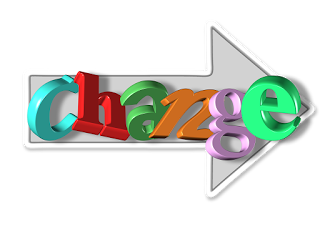 Change is inevitable, organizational change has become a common practice within an organization, but too often changes are made as a reaction to outer impulses, crisis, and demands. This is the bureaucracy’s way of meeting the challenges. A digital transformation is achieved via dynamic Strategy-Execution-Change life cycle management, though it is not all linear steps, but an iterative, ongoing and upgoing change continuum. How to ride ahead of the change curve and lead change effortlessly?
Change is inevitable, organizational change has become a common practice within an organization, but too often changes are made as a reaction to outer impulses, crisis, and demands. This is the bureaucracy’s way of meeting the challenges. A digital transformation is achieved via dynamic Strategy-Execution-Change life cycle management, though it is not all linear steps, but an iterative, ongoing and upgoing change continuum. How to ride ahead of the change curve and lead change effortlessly?
How to Manage those Change Management Dilemmas Why is Successful Change so Difficult? The phrase "The only constant changes" refers to the obvious fact that we see all around us which is that things are constantly changing. The pace of change is accelerated in every vertical sector, and even every corner of the world, however, 70% of change management projects failed, why change, or more precisely, successful change is so difficult??
Change, or Resistance to Change, What’s the Problem? Change is the only constant, but most of the change management efforts fail. Indeed, change is difficult, some say, change is not a problem, the primary reason for change failure is resistance to change while the secondary reason is the inability of leaders to deal with resistance. What are the true problems of the change, or what’re the real roadblocks to step into changes?
Which is Better Strategy: Adapt to Change or Mitigate the Change? Change is inevitable ,the speed of change is expedited. There are too many different types of change management initiatives, so there is no one size fits all approach to successfully managing change. Organizations today are more dynamic than ever, there are Big’C’ changes such as digital transformation, merging organizations with overlapping or duplicate functions, and little ‘c’changes such as implement a new software tool, reorganize a department, improving a new process to do things more efficiently. But too often changes are made as a reaction to outer impulses, crisis, and demands. Which one is the better strategy: Adapting to a changing climate, or taking logical steps to mitigate the changes that are already underway?
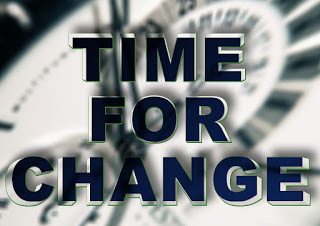 Add captionIs Uncertainty Problem or Opportunity: Uncertainty and ambiguity are a key challenge for business leaders today. In the past, many business leaders believed their organizations’ long-term goals could wait until they had dealt with the current crisis. In the current business environment with “VUCA” characteristics, this is no longer the case. The rate of change has accelerated, indicating that business leaders must learn how to strike a balance between managing complex issues today and predicting the uncertain issues of tomorrow. So is uncertainty the biggest problem in business today? And is it affecting business in setting long-term strategies and are forced to concentrate on short term goals? And further questions include - how can the soft signals of contextual changes be best determined? How do you structure information systems to deal with uncertainty - in the era of Digital?
Add captionIs Uncertainty Problem or Opportunity: Uncertainty and ambiguity are a key challenge for business leaders today. In the past, many business leaders believed their organizations’ long-term goals could wait until they had dealt with the current crisis. In the current business environment with “VUCA” characteristics, this is no longer the case. The rate of change has accelerated, indicating that business leaders must learn how to strike a balance between managing complex issues today and predicting the uncertain issues of tomorrow. So is uncertainty the biggest problem in business today? And is it affecting business in setting long-term strategies and are forced to concentrate on short term goals? And further questions include - how can the soft signals of contextual changes be best determined? How do you structure information systems to deal with uncertainty - in the era of Digital?
Is Hierarchy Good or Bad for Systems?? Systems Thinking is the ability to think the "whole," and understand the interconnectivity of its parts as well. As complexity is pushing the boundaries of the thinking and traditional systems, what we do know is "that larger and more complicated systems" do not have the requisite agility to adapt to more complex and adaptive environments.The more nonlinear, interconnected, and interdependent the environment, where uncertainty and emergence become more prevalent, hence accelerated rates of change, the less likely ordered hierarchical systems are to be the answer due to the rigidity. Hence, we need to adapt to the Systems Thinking and reimagine the digital organizational structure?
Blogging is not about writing, but about thinking; it’s not just about WHAT to say, but about WHY to say, and HOW to say it. It reflects the color and shade of your thought patterns, and it indicates the peaks and curves of your thinking waves. Unlike pure entertainment, quality and professional content takes time for digesting, contemplation and engaging, and therefore, it takes the time to attract the "hungry minds" and the "deep souls." It’s the journey to amplify your voice, deepen your digital footprints, and match your way for human progression.Follow us at: @Pearl_Zhu
Published on October 07, 2016 22:48
Thinkingaire" Book Quote Collection Part II
 The term digital " THINKINGAIRES" we advocate in this book refers to the talented digital leaders and professionals who continue to create new ideas, to practice thought leadership, and to bring the world both content richness and context intelligence. Here is a set of quote collections from "Thinkingaire," to convey the quintessential of multidimensional digital thinking.
The term digital " THINKINGAIRES" we advocate in this book refers to the talented digital leaders and professionals who continue to create new ideas, to practice thought leadership, and to bring the world both content richness and context intelligence. Here is a set of quote collections from "Thinkingaire," to convey the quintessential of multidimensional digital thinking.
25 At its core, “agile” is a mindset, a way of looking at the world and a way of thinking about work.26 When you learn something new, the structure of your brain changes. 27 A programmable mind embraces mental agiity, to practice “de-learning” and “relearning” all the time.28 Trust is a collective mind within the corporate culture. You can’t build and nourish trust without creating an environment conductive to trust. 29 Clarity is a perception; it’s an emotional alignment of thoughts, intuitions, inclinations, expression and expectations. 30 Learning is the way to keep your mind flowing, and hence your life flowing.31 Setting the right priorities or having superior time management skill means knowing the difference between “must have,” and “nice to have.”32 A flexible mind has a better chance to think differently and take a unique path in the life journey.33 An adaptive mind has better learning capability.34 A data-savvy mind can lead more persuasive and evidence-based communication.35 Understanding requires a person’s ability to grasp or comprehend information.36 Cognition can happen in many different ways and combinations.37 Insight is vision through the ‘mind’s eyes.38 Intellectuals are intelligent, knowledgeable, articulate and curious.39 Judgment and decision making are often considered together.40 The ultimate aim of learning knowledge is to gain wisdom.41 A high EQ mind maintains its composure whatever the situation, whether it is being glorified or vilified.42 Self-discipline is nothing but self-consciousness.43 Only a positive mind can move the world forward.44 When there is fear, there is no trust45 Digital is the age of empathy.46 An accountability mind has learned to be agile, wise, courageous, resilient, and high-mature.47 The gravitas in a leader is like clarity in diamond.48 A peaceful mind is not a matter of doing, but of being. 49 Resilience is about B.O.U.N.C.E-Bouncing forward includes bouncing back.
50 A grit mind strengthens all of your strengths.
Follow us at: @Pearl_Zhu
Published on October 07, 2016 22:46
Reinventing IT via Digitization, Simplification and innovation
 IT organizations are facing significant transformation, perhaps crossroad is an appropriate word to articulate IT position: Should IT keep running as a transactional support desk or cost center, or can IT reinvent itself as a changing organization to drive digital transformation of the business via digitization, simplification, and innovation?
IT organizations are facing significant transformation, perhaps crossroad is an appropriate word to articulate IT position: Should IT keep running as a transactional support desk or cost center, or can IT reinvent itself as a changing organization to drive digital transformation of the business via digitization, simplification, and innovation?
IT should be seen by any business as a strategic partner and “digital transformer”: The CIO and the IT department effectively enables and facilitates the business strategy and objectives, and ultimately digital transformation. Forward-looking IT organizations declare they are in the information management business. There are very few businesses today can state that IT does not play a significant role in the day to day operations or even long-term strategic positioning. Organizations need to take that into consideration when establishing strategic goals to manage their digital transformation. To effectively “support” business strategic execution, IT must sit at the table as a business line and be a key player in the development of the business strategy before execution. The focus of IT and the CIO should be business centric and tightly integrated into the decision process. Further, IT department should not live in a silo, or a function running as a help desk only. Mappings of high-level business processes to technology must be in place to allow for an understanding of the impact of strategic changes, and to open discussion across business lines on the steps that need to be taken to reach strategic goals.
IT should reinvent itself via following simplicity principle, even though complexity is an innate nature of technology: Keep things simple, not simpler. Organizations are indeed becoming more complex.Overcoming complication and managing complexity become one of the biggest challenges in business today. In a corporate world, you will find the attitude of complicating things in systems and procedures and people love to hang on to the complications and express how they are experts in dealing with complications, this is often the case in IT, take the projects as technique challenges only, without “keeping the end in mind,” help to solve business problems with prioritization skills. IT leaders need to be like gardeners, continue to weed out redundancy, and keep IT fit via consolidation, integration, modernization, optimization, and innovation, Continuous attention to technical excellence and good design enhances agility can drive the team towards complex, but efficient, low overhead practices, rather than just simplicity. There are always constraints, so simplicity implies to build as little as possible (as little output as possible, to maximize the amount of work not done) and maximize outcome (benefit for users/customers).
 IT should unmystified innovation puzzle and manage innovation in a structural way: The available digital technology just makes innovation easier to do now than in the past, less costly, more easily accessible. Unfortunately, in most of the organizations, innovation is still a serendipity. An enterprise that depends on doing something, again and again, engaging various teams and groups, have less appetite for change.IT leaders need to manage innovation portfolio including both incremental innovation and disruptive innovation in a systematic way. Digital IT is a paradigm shift in role, responsibility and attitude. The CIO role has never been about just managing the status quo, so the digital shift for IT in some industries is to be innovative with systems of engagement. IT needs to know when to work in the system, and when to work on the system, if you can innovate across the business, regardless of which function you are involved in, be it IT, HR, Finance etc. then you can surely change the shape of what you deliver, not just how it's delivered. Any organization that can capitalize on innovations, be they in-house or externally derived and delivered, is going to be agiler, and ultimately more successful.
IT should unmystified innovation puzzle and manage innovation in a structural way: The available digital technology just makes innovation easier to do now than in the past, less costly, more easily accessible. Unfortunately, in most of the organizations, innovation is still a serendipity. An enterprise that depends on doing something, again and again, engaging various teams and groups, have less appetite for change.IT leaders need to manage innovation portfolio including both incremental innovation and disruptive innovation in a systematic way. Digital IT is a paradigm shift in role, responsibility and attitude. The CIO role has never been about just managing the status quo, so the digital shift for IT in some industries is to be innovative with systems of engagement. IT needs to know when to work in the system, and when to work on the system, if you can innovate across the business, regardless of which function you are involved in, be it IT, HR, Finance etc. then you can surely change the shape of what you deliver, not just how it's delivered. Any organization that can capitalize on innovations, be they in-house or externally derived and delivered, is going to be agiler, and ultimately more successful.
Technology is pervasive, business transformation or change initiatives today nearly always involves some form of technology implementation. IT should help the company achieve its business objectives in any way possible and the first step is forging close relationships with the senior execs and business managers to really understand their goals and plans for expanding their area; at premium level, IT needs to drive changes and reinvent itself and the business as a whole via digitization, simplification, and innovation.
Follow us at: @Pearl_Zhu
Published on October 07, 2016 22:44
October 6, 2016
The Weekly Insight of the “Future of CIO” 10/6/ 2016
 The “Future of CIO” Blog has reached 1.5 million page views with 3100+ blog posting in 59+ different categories of leadership, management, strategy, digitalization, change/talent, etc. The content richness is not for its own sake, but to convey the vision and share the wisdom. Here is the weekly insight about digital leadership, IT Management, and Talent Management.
The “Future of CIO” Blog has reached 1.5 million page views with 3100+ blog posting in 59+ different categories of leadership, management, strategy, digitalization, change/talent, etc. The content richness is not for its own sake, but to convey the vision and share the wisdom. Here is the weekly insight about digital leadership, IT Management, and Talent Management.
The Weekly Insight of the “Future of CIO” 10/6/2016"CIO Master" #108: The Logical Scenario for Driving IT Digital Transformation: Technology is pervasive nowadays, business transformations or any business initiatives today nearly always involves some form of technology implementation and information analysis; IT touches both hard business processes and soft human behavior. IT itself is also on the journey of digital transformation, why does IT needs to do this, what’s the logical scenario to take, and what outcome IT expects to achieve??
The new book “Change Insight” Preview: Change is inevitable, you can’t step into the same river twice, meaning that everything is always in a state of flow. But too often changes are made as a reaction to outer impulses, crisis, and demands. This is the bureaucratic way of meeting the challenges. Change is never for its own sake. The true reason behind the change is either due to the ineffectiveness of teams/organizations or the inefficiency of processes/practices.
The Monthly Insight of the Board Room: An IT-Friendly Boardroom Oct., 2016 Modern corporate boards play significant roles in guiding businesses toward the right direction and achieve expected business results. Due to the “VUCA” characteristics -Complexity, Uncertainty, Ambiguity and Velocity of the Digital Era, the directorship in any organization must have agility to adapt to change and build abilities to advise, inspire and motivate a group of people toward accomplishing shared visions and goals."CIO Master" Book Tuning #107: Three “Soft” IT Management Disciplines to Drive Digital Transformation: Often, IT is perceived by the business as a big cold, isolated function with monolithic hard boxes and tangled wires, surrounding with IT staff stereotyped as geeks who speak the different language and lack of business acumen to ask insight questions. With emergent digital technologies and increasing paces of changes, forward-looking IT organizations are reaching the inflection point for digital transformation, and shift from “T-driven” monolithic type to “I” oriented mosaic style. To soften the"hard image," what are the “soft” IT management disciplines to drive digital transformation?
 The New book “Thinkingaire” Conclusion: Hire digital mindsets, train for skills: Many of us like the mantra: “Hire character, train for skills.” That indicates how important it is to get the “raw talent” or the right attitude. Another way to say it could be “Hire digital mindset, train for knowledge.” Formal education can teach you a certain level of knowledge, but it cannot teach you how to think. Experience can make you fluent in certain linear skills, but without thinking capacity, you can not further sharpen synthesizing or recombinant capabilities to expand your horizons. It is important to cultivate a healthy thinking habit in making sound judgments and effective decisions on the daily basis. The book "Thinkingaire" is not to teach you knowledge about the brain, but to guide you on how to think broadly, think profoundly, think critically, think creatively, and think holistically. Simply put, to become a "Digital Thinkingaire." Blogging is not about writing, but about thinking and innovating the new ideas; it’s not just about WHAT to say, but about WHY to say, and HOW to say it. It reflects the color and shade of your thought patterns, and it indicates the peaks and curves of your thinking waves. Unlike pure entertainment, quality and professional content takes time for digesting, contemplation and engaging, and therefore, it takes the time to attract the "hungry minds" and the "deep souls." It’s the journey to amplify diverse voices and deepen digital footprints, and it's the way to harness your innovative spirit.
The New book “Thinkingaire” Conclusion: Hire digital mindsets, train for skills: Many of us like the mantra: “Hire character, train for skills.” That indicates how important it is to get the “raw talent” or the right attitude. Another way to say it could be “Hire digital mindset, train for knowledge.” Formal education can teach you a certain level of knowledge, but it cannot teach you how to think. Experience can make you fluent in certain linear skills, but without thinking capacity, you can not further sharpen synthesizing or recombinant capabilities to expand your horizons. It is important to cultivate a healthy thinking habit in making sound judgments and effective decisions on the daily basis. The book "Thinkingaire" is not to teach you knowledge about the brain, but to guide you on how to think broadly, think profoundly, think critically, think creatively, and think holistically. Simply put, to become a "Digital Thinkingaire." Blogging is not about writing, but about thinking and innovating the new ideas; it’s not just about WHAT to say, but about WHY to say, and HOW to say it. It reflects the color and shade of your thought patterns, and it indicates the peaks and curves of your thinking waves. Unlike pure entertainment, quality and professional content takes time for digesting, contemplation and engaging, and therefore, it takes the time to attract the "hungry minds" and the "deep souls." It’s the journey to amplify diverse voices and deepen digital footprints, and it's the way to harness your innovative spirit.Follow us at: @Pearl_Zhu
Published on October 06, 2016 22:40
The New Book “Change Insight” Preview
“The only things that evolve by themselves in an organization are disorder, friction, and malperformance. ” — Peter Drucker
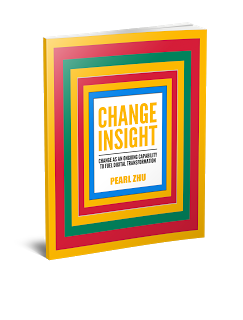 Change is inevitable, you can’t step into the same river twice, meaning that everything is always in a state of flow. But too often changes are made as a reaction to outer impulses, crisis, and demands. This is the bureaucratic way of meeting the challenges. Change is never for its own sake. The true reason behind the change is either due to the ineffectiveness of teams/organizations or the inefficiency of processes/practices.
Change is inevitable, you can’t step into the same river twice, meaning that everything is always in a state of flow. But too often changes are made as a reaction to outer impulses, crisis, and demands. This is the bureaucratic way of meeting the challenges. Change is never for its own sake. The true reason behind the change is either due to the ineffectiveness of teams/organizations or the inefficiency of processes/practices.
There are many books written about changes, but very few dig into the mindset level. Change Management starts with a thought, with a flash of insight, insight is the act or result of understanding the inner nature of changes or of seeing things intuitively. It leads to a vision; then leads to a culture shift, strategic changes, or leadership transformation. It’s important to understand the big WHY about changes, no change is for its own sake, the first step is to define the value proposition and determine demand and estimated pipeline. Insight is thinking into the box after thinking out of the box. Thus, insight takes creativity and reasoning, intuition and logic, the power of acute observation and deduction, questioning, connection, penetration, and discernment. Change Insight is the understanding of a specific cause and effect in a specific change context. Change Insight is being able to identify the root cause of a problem or the core issues of a situation, which leads to understanding and resolution about changes. Change has different scopes and effects, from small changes such as software updating, business process tuning; to radical changes such as culture innovation, or big-bang changes such as radical digital transformation. Often change is an “un” nature activity, you need to focus, also, make an effort to sustain it. So the newly established behaviors or the new way to work will be in harmony with the well-defined value propositions so that change can maintain its momentum. Too often, people take the easy path, think and work at a superficial level rather than spending the time to understand what’s going on underneath. Insight is the understanding of cause and effect, based on the identification of relationships and behaviors within a model, context, or scenario in Change Management.
 Change Management is always challenging with a high percentage of failure rate. Indeed, change is difficult. Some say, change is not a problem, the primary reason for change failure is resistance to change while the secondary reason is the inability of leaders to deal with resistance. The purpose of the book “Change Insight” is to:Dig deeper to analyze the psychology behind changes and handle problems and changes at the level of the mindset.Explore people-centric change management philosophy and practices.Differentiate change leadership and change management, orchestrate change at all level of the organization.Set Change Management principles to inform and support the way of managing change effectively.Build change as an ongoing capability, not just a one-time business initiative.Analyze the potential change pitfalls and roadblocks on the change journey.Make objective change assessment and measurement from multidimensional lens.And ultimately build high-mature organizations with changeability to fuel the digital transformation.
Change Management is always challenging with a high percentage of failure rate. Indeed, change is difficult. Some say, change is not a problem, the primary reason for change failure is resistance to change while the secondary reason is the inability of leaders to deal with resistance. The purpose of the book “Change Insight” is to:Dig deeper to analyze the psychology behind changes and handle problems and changes at the level of the mindset.Explore people-centric change management philosophy and practices.Differentiate change leadership and change management, orchestrate change at all level of the organization.Set Change Management principles to inform and support the way of managing change effectively.Build change as an ongoing capability, not just a one-time business initiative.Analyze the potential change pitfalls and roadblocks on the change journey.Make objective change assessment and measurement from multidimensional lens.And ultimately build high-mature organizations with changeability to fuel the digital transformation.
“Change Insight” Book Introduction SlideshareFollow us at: @Pearl_Zhu
 Change is inevitable, you can’t step into the same river twice, meaning that everything is always in a state of flow. But too often changes are made as a reaction to outer impulses, crisis, and demands. This is the bureaucratic way of meeting the challenges. Change is never for its own sake. The true reason behind the change is either due to the ineffectiveness of teams/organizations or the inefficiency of processes/practices.
Change is inevitable, you can’t step into the same river twice, meaning that everything is always in a state of flow. But too often changes are made as a reaction to outer impulses, crisis, and demands. This is the bureaucratic way of meeting the challenges. Change is never for its own sake. The true reason behind the change is either due to the ineffectiveness of teams/organizations or the inefficiency of processes/practices. There are many books written about changes, but very few dig into the mindset level. Change Management starts with a thought, with a flash of insight, insight is the act or result of understanding the inner nature of changes or of seeing things intuitively. It leads to a vision; then leads to a culture shift, strategic changes, or leadership transformation. It’s important to understand the big WHY about changes, no change is for its own sake, the first step is to define the value proposition and determine demand and estimated pipeline. Insight is thinking into the box after thinking out of the box. Thus, insight takes creativity and reasoning, intuition and logic, the power of acute observation and deduction, questioning, connection, penetration, and discernment. Change Insight is the understanding of a specific cause and effect in a specific change context. Change Insight is being able to identify the root cause of a problem or the core issues of a situation, which leads to understanding and resolution about changes. Change has different scopes and effects, from small changes such as software updating, business process tuning; to radical changes such as culture innovation, or big-bang changes such as radical digital transformation. Often change is an “un” nature activity, you need to focus, also, make an effort to sustain it. So the newly established behaviors or the new way to work will be in harmony with the well-defined value propositions so that change can maintain its momentum. Too often, people take the easy path, think and work at a superficial level rather than spending the time to understand what’s going on underneath. Insight is the understanding of cause and effect, based on the identification of relationships and behaviors within a model, context, or scenario in Change Management.
 Change Management is always challenging with a high percentage of failure rate. Indeed, change is difficult. Some say, change is not a problem, the primary reason for change failure is resistance to change while the secondary reason is the inability of leaders to deal with resistance. The purpose of the book “Change Insight” is to:Dig deeper to analyze the psychology behind changes and handle problems and changes at the level of the mindset.Explore people-centric change management philosophy and practices.Differentiate change leadership and change management, orchestrate change at all level of the organization.Set Change Management principles to inform and support the way of managing change effectively.Build change as an ongoing capability, not just a one-time business initiative.Analyze the potential change pitfalls and roadblocks on the change journey.Make objective change assessment and measurement from multidimensional lens.And ultimately build high-mature organizations with changeability to fuel the digital transformation.
Change Management is always challenging with a high percentage of failure rate. Indeed, change is difficult. Some say, change is not a problem, the primary reason for change failure is resistance to change while the secondary reason is the inability of leaders to deal with resistance. The purpose of the book “Change Insight” is to:Dig deeper to analyze the psychology behind changes and handle problems and changes at the level of the mindset.Explore people-centric change management philosophy and practices.Differentiate change leadership and change management, orchestrate change at all level of the organization.Set Change Management principles to inform and support the way of managing change effectively.Build change as an ongoing capability, not just a one-time business initiative.Analyze the potential change pitfalls and roadblocks on the change journey.Make objective change assessment and measurement from multidimensional lens.And ultimately build high-mature organizations with changeability to fuel the digital transformation.“Change Insight” Book Introduction SlideshareFollow us at: @Pearl_Zhu
Published on October 06, 2016 22:38



